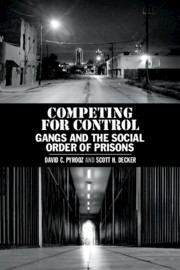Book contents
- Competing for Control
- Competing for Control
- Copyright page
- Contents
- Figures
- Tables
- Acknowledgments
- 1 Foundation for the Study
- 2 Understanding Gangs in Prison
- 3 The LoneStar Project
- 4 The Characteristics of Gang Members in Prison
- 5 The Characteristics of Gangs in Prison
- 6 The Role of Gangs in the Social Order of Prisons
- 7 Misconduct and Victimization in Prison
- 8 Joining and Avoiding Gangs in Prison
- 9 Continuity and Change in Prison Gang Membership
- 10 Implications of Competing for Control
- Appendix Preliminary Evaluation of the Gang Renouncement and Disassociation Program
- References
- Index
8 - Joining and Avoiding Gangs in Prison
Published online by Cambridge University Press: 09 August 2019
- Competing for Control
- Competing for Control
- Copyright page
- Contents
- Figures
- Tables
- Acknowledgments
- 1 Foundation for the Study
- 2 Understanding Gangs in Prison
- 3 The LoneStar Project
- 4 The Characteristics of Gang Members in Prison
- 5 The Characteristics of Gangs in Prison
- 6 The Role of Gangs in the Social Order of Prisons
- 7 Misconduct and Victimization in Prison
- 8 Joining and Avoiding Gangs in Prison
- 9 Continuity and Change in Prison Gang Membership
- 10 Implications of Competing for Control
- Appendix Preliminary Evaluation of the Gang Renouncement and Disassociation Program
- References
- Index
Summary
Life is a series of transitions across institutions, relationships, and roles. People age, develop new identities, assume new roles, and change associates, friends, and even family. Joining a gang is one of the critical transitions that may occur in the life course. Although group processes and structures are both central to this book, up to this point we have paid more empirical attention to the latter. We have compared the members of gangs to inmates who were not affiliated with gangs. In addition, we examined the form and function of the different structures of gangs behind bars, including their role in the governance of prisons as well as misconduct and victimization. In this chapter, we focus on a crucial aspect of group process: joining a gang. If transitions into new identities, roles, and statuses are consequential for the life course, we ought to learn about how such transitions unfold, especially if they occur in places like prisons that are tasked with the job of rehabilitation.
- Type
- Chapter
- Information
- Competing for ControlGangs and the Social Order of Prisons, pp. 181 - 216Publisher: Cambridge University PressPrint publication year: 2019

